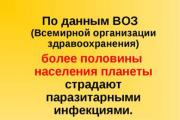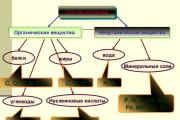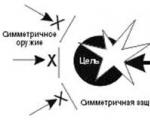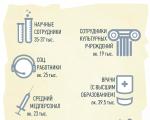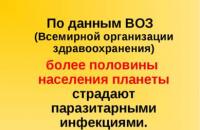06.07.2022
Lecture materials on labor protection. Training of employees on labor protection within the organization
In this article, we will look at occupational safety training at enterprises: what categories of workers are required to undergo occupational safety training within the organization, how the occupational safety training for managers and specialists differs from the training of workers who supervise the training.
Training workers on labor protection in an organization is one of the most important aspects of labor protection. During occupational safety training at enterprises, workers receive necessary knowledge and safe work skills that will help them maintain health and ability to work.
Basic parameters of occupational safety training within the organization
Intra-enterprise occupational safety training is characterized by:
1.
Regulatory documentation establishes clear deadlines for all types, as well as working professions. These deadlines are strictly adhered to.
2.
Narrow focus.
During training, workers receive knowledge only in their specialties, professions, and types of work. No information for general development» is not given to them.
3.
Variability.
The legislation has a democratic approach to the format of safety training. It can be conducted in the classic lecture/practice format, in the form of a seminar, consultation, using automated methods (computer programs, simulators), and even remotely. The main thing is that the level of knowledge of employees is sufficient to perform the work safely.
4.
Equal demands
.
Everyone who works in the organization, including top management and even directors, is required to undergo occupational safety training. Of course, training programs vary depending on the profession and job responsibilities. For some, this will be enough, but for others, they will have to obtain more than one certificate for the right to perform particularly dangerous work.
OSH training for managers and specialists
You can conduct it in your organization or in specially created training centers.
In organizations, special commissions are created for these purposes, which at the end of the training test the acquired knowledge.
The first such training is completed by an occupational safety specialist or manager no later than 1 month after employment. The procedure is then repeated every 3 years.
The following are required to undergo occupational safety training:
➤
managers, directors of organizations,
their deputies, persons who perform their duties. This category of trainees also includes individual entrepreneurs;
➤
managers structural divisions, services
, departments of organizations and their deputies;
➤
persons who organize work
and directly supervise their implementation: foremen, foremen;
➤
Engineers who control the quality of work
, incl. with OT specialists;
➤
union members
;
➤
representatives of labor collectives for occupational safety
.
In some cases, the above listed persons are required to undergo occupational safety training earlier than after 3 years if:
➤ due to their fault, an accident occurred in the organization;
➤ new regulations have come into force that relate to their work;
➤ during the inspection, the inspector identified violations that arose due to the incorrect actions of these employees;
➤ there have been changes in technological process in the areas entrusted to them: new equipment was launched, other types of work appeared, raw materials changed, new structural divisions were added, workers of other professions came to work, etc.;
➤ they move to another position;
➤ they did not comply job responsibilities more than 12 months in a row ( maternity leave, moving to another job, etc.).
Conducted according to special programs. Training programs developed within the enterprise are approved by the employer. The programs developed by training centers are approved by federal or regional executive authorities that oversee the occupational safety and health sector. If the legislation and production processes have not changed in 3 years, the engineer will have to take exactly the same course that he took before.
Occupational safety and health training within the organization for workers
Everyone who works in the organization is required to undergo regular occupational safety training. For representatives of working professions, it is divided into two types: training by type of work (professions) and instruction.
Occupational safety training during work performance is carried out in the organization no later than 1 month from the date of employment of the employee. The same period is given to retrain OT rules for persons who:
➤ moved to another job;
➤ have not performed work that requires increased safety requirements for 1 year or longer.
Such training of employees on labor protection is also carried out during retraining, obtaining new working specialty. Before being allowed to perform work independently, workers undergo duplication or internship.
Within the first month of employment, new employees must learn first aid. In the future, they are required to undergo this occupational safety training annually. It is carried out by the organization or in a training center.
The instructions are carried out as follows:
➤ as soon as the worker has crossed the threshold of the organization - introductory;
➤ as soon as he first got to his workplace or is about to start a new type of work - primary;
➤ periodically during work (maximum break - 6 months) - repeated. It is carried out in the same volumes as the primary one;
➤ if in production process changes have occurred, new instructions and regulations have been put into effect, an accident has occurred (in the organization itself or at a related enterprise), the administration has new information on occupational safety that needs to be brought to the attention of workers - unscheduled;
➤ before carrying out one-time work, mass events, and also in the case of issuing a work permit - targeted.
The instruction program includes instructions on the profession or types of work that the employee performs. The program of unscheduled and targeted instructions depends on the reason for their implementation.
The fundamental difference between instruction and training in labor protection within the framework of a certain profession or type of work lies in its local action. The mark on the training “works” only at the enterprise where it was carried out. It does not apply to other enterprises. For example, if on Monday an electrician of a repair organization screws in light bulbs for the first time in his life at one enterprise, on Tuesday at another, and on Wednesday at a third, then he will have to undergo 3 introductory briefings and 3 initial ones. At the same time, his professional training and certificate in electrical safety, other occupational safety training that he received in his organization (for example, on working at height), are valid at all three enterprises.
Who controls the training of employees on labor protection
The timeliness, quality and completeness of training of workers on labor protection in the organization are controlled by occupational safety specialists. They have the right to check availability and quality this training all employees without exception. For violations discovered by them, fines are imposed on those responsible.
The same amount of work can be done by inspectors of the State Technical Inspectorate, as well as specialized institutions (Gosgortekhnadzor, Gosenergonadzor, etc.). At the same time, they will monitor the quality of training of the OT service employees themselves. For failure to conduct occupational safety training in the prescribed manner, they impose penalties on those responsible for this officials administrative fines. If a person commits such an offense repeatedly, he may lose the right to hold his position for 1-3 years. The fine in this case increases significantly.
How is OT training conducted for individual entrepreneurs?
If an individual entrepreneur uses the labor of hired workers or specialists, he conducts labor safety training and instructions in the same way as is done in large organizations. Therefore, such entrepreneurs are required to undergo labor safety training. He organizes training for his employees in accordance with their positions, professions, and work performed. The only significant difference is that individual entrepreneurs with a small staff have to resort to the services of training centers. The main reason is that there are not enough trained engineers to create a commission on and develop training programs and conduct such training on our own inappropriate in economically.
Individual entrepreneurs who do not use hired labor are also required to undergo occupational safety training. Despite the fact that their “work life” is simpler than that of their subordinate colleagues burdened with health concerns, they need to take care of their own safety and the health of the people who interact with them (neighbors, clients, random passers-by). Therefore, they need to be trained in the rules of safe use of equipment, fire safety, first aid, and obtain at least Group I in electrical safety. It would not be amiss to draw up instructions for the safe performance of work and operation of equipment and periodically review their provisions. Such self-education will help maintain health or even life while performing current work or in an emergency situation, so it will never be superfluous.
Training employees on labor protection is an important event aimed at ensuring the safety of the work process at the enterprise. This article will discuss how to organize staff training and what you need to know for this.
Conducting training and instructing workers on labor protection (OHS)
According to the law, every employee of the organization must be provided with such labor conditions, which meet all the requirements for his safety, while being a guarantee that the employee’s work activities are protected (Article 219 of the Labor Code of the Russian Federation). In this regard, the state puts forward a number of occupational safety requirements, which the employer must strictly observe, and the conditions for their implementation are enshrined in employment contracts with each employee (part 1.2 of article 220 of the Labor Code of the Russian Federation).
Art. 225 of the Labor Code of the Russian Federation establishes the fundamental rules for training in the field of occupational safety at an enterprise:
- All persons working in the organization must be trained in occupational safety and undergo testing of relevant knowledge. We are talking about both managers (as well as employers - individual entrepreneurs) and ordinary employees.
- For citizens hired for the first time (including by way of transfer), the employer's representative is required to provide occupational safety training. In addition, it is necessary to provide training on safe methods of implementation. labor function, as well as methods of providing first aid to injured employees medical care.
- For persons applying for jobs in which conditions are dangerous or harmful, the employer must provide training followed by internships and exams. At the same time, it is necessary to train employees and test their knowledge regularly, throughout the entire period of their work.
- For the purpose of qualified training of specialists in the field of occupational safety, organizations receive support from the state. It is also intended to provide assistance in these matters to institutions providing general education services.
OT training
On January 13, 2003, a joint resolution of the Ministry of Labor of the Russian Federation and the Ministry of Education of the Russian Federation No. 1/29 approved the Procedure for training in occupational safety and testing the knowledge of occupational safety of employees of organizations (hereinafter referred to as the Procedure). In accordance with this document, the employer is responsible for the timely preparation and conduct of such an event (clause 1.7 of the Procedure).
Thus, clause 2.1 of the Procedure imposes on a person (a specialized occupational safety specialist or an employee authorized by order of the manager) the responsibility for instructing employees who have been rehired or received a position through transfer.
Instruction includes the employee studying production factors that may be dangerous or harmful, becoming familiar with occupational safety requirements, instructions and other documents, as well as taking measures that are safe when carrying out work (part 3, clause 2.1.3 of the Procedure).
The briefing ends:
- oral verification by the instructing person of the acquired knowledge by the employee (part 4, clause 2.1.3 of the Procedure);
- registration of the event in a special journal with the signatures of the persons participating in this event and its date (part 5, clause 2.1.3 of the Procedure).
An occupational safety specialist or an employee who is assigned this responsibility by order of the director of the organization (clause 2.1.2 of the Procedure) is authorized to conduct instructions. This person must be the work manager, be trained in the basics of occupational safety and tested regarding the knowledge acquired. This requirement does not apply to persons conducting induction training (clause 2.1.3 of the Procedure).
Types of instruction
- Introductory. It is carried out until the citizen begins his work, according to a program, the content of which is based on the specifics and characteristics of the enterprise’s activities (clause 2.1.2 of the Procedure);
- Primary. Organized with the participation of all employees newly employed in the organization, as well as transferred from another enterprise or who received new position. The employer has the right to approve a list of positions or professions of employees of the organization who are exempt from the need to receive this instruction (clause 2.1.4 of the Procedure);
- Repeated. Carried out in relation to employees and according to the initial briefing program, at least once every six months (clause 2.1.5 of the Procedure);
- Unscheduled. Carried out in the following cases (clause 2.1.6 of the Procedure):
- the entry into force of new legislative norms, instructions in the field of occupational safety or their changes;
- changes in technological processes, replacement or improvement of equipment, working tools and other conditions that may affect the safety of the labor process;
- serious violations of occupational safety requirements committed by employees, which could lead to serious consequences;
- issuing orders for training by regulatory or supervisory authorities;
- interruption of the work process for more than 2 months, and in harmful or dangerous industries - more than 1 month;
- making a decision by the head of the organization or a person authorized to do so.
- Target. Organized at (clause 2.1.7 of the Procedure):
- performing work of a one-time nature;
- eliminating the consequences of industrial accidents and natural disasters;
- carrying out work for which special documents must be drawn up (permits, permits, work orders);
- holding events at the enterprise with a large number of participants.
The timing and procedure for conducting the above briefings in individual organizations or areas are regulated by the relevant norms of industry (intersectoral) legal acts on occupational safety (clause 2.1.8 of the Procedure).
Training of specialists and managers in labor protection
Person settling down on leadership position, as well as specialized specialists, are required to undergo occupational safety training to the extent that they are expected to perform their job duties. This must be done before completing 1 month of work, then at least once every 3 years. In addition, appointed persons must be familiar with their occupational safety responsibilities even before they begin to independently perform their labor functions (clause 2.3.1 of the Procedure).
The above employees of the company can undergo training:
- in institutions whose activities are aimed at providing this type of educational services(if there are teachers and an appropriate license) (clause 2.3.2 of the Procedure);
- V own organization provided that it has formed a commission to verify the knowledge acquired by persons (paragraph 10, clause 2.3.2 of the Procedure).
The requirements for general education institutions are approved by the Ministry of Labor of the Russian Federation with their further approval by the Ministry of Education of the Russian Federation (clause 2.3.3 of the Procedure).
It is worth noting that managers and specialized specialists must also undergo occupational safety training in the event of improving their qualifications in their main job (part 3, clause 2.3.6 of the Procedure).
Don't know your rights?
The procedure for preparing and training employees in occupational safety and health professions at the enterprise
Employees of blue-collar occupations, along with other employees of the enterprise, must undergo occupational safety training organized by the employer if they re-entered or were transferred to work. In this case, initial briefing must be carried out during the first month of their work (clause 2.2.1 of the Procedure).
In the event that a worker has to work on hazardous production or in conditions that create a danger to his health or life, the employer is obliged in relation to him (clause 2.2.2 of the Procedure):
- provide training on occupational safety;
- organize internships and final exams;
- conduct systematic training and testing of knowledge on occupational safety throughout the entire period of work.
At least once a year, the employer must conduct training among workers to provide initial medical care to persons injured while performing work. First-time hired workers must undergo such training before the end of 1 month of their work (clause 2.2.4 of the Procedure).
The procedure, terms and duration of occupational safety training, as well as testing the existing knowledge of workers, are approved by the employer on the basis of legal acts establishing safety standards individual species works (clause 2.2.3 of the Procedure).
Employee training program and plan on labor protection: sample
|
|
| Download the Program form
|
On May 17, 2004, the Ministry of Labor of the Russian Federation approved a sample program and plans for training OT employees and testing their knowledge.
The program is designed to provide students with the opportunity to acquire knowledge and skills in the field of occupational safety for the purpose of their further application in practice. It consists of 4 sections, which include topics in the OT discipline:
- OT basics;
- basics of occupational safety management in an organization;
- issues related to ensuring compliance with occupational safety requirements and workplace safety;
- measures social support and protection of injured persons at work.
Upon completion of the program course, as well as after testing the acquired knowledge in the field of occupational safety in an organization specializing in the provision of this type of educational services, students are issued certificates that confirm the fact that they have completed their studies.
The plan provides a list of 10 categories of persons who must take a course in occupational safety:
- directors of organizations and their deputies, as well as individual entrepreneurs;
- specialists whose responsibilities include organizing production work and exercising control;
- OT service employees;
- representatives of commissions and committees on occupational safety;
- members of trade unions and other bodies representing the organization in labor matters;
- specialists from federal ministries and other departments of the Russian Federation in the field of occupational safety;
- specialists from executive authorities in the constituent entities of the Russian Federation in the field of occupational safety;
- teachers of general education institutions teaching disciplines related to OT;
- representatives of commissions for testing acquired knowledge by employees of the enterprise;
- mixed groups of employees of institutions and organizations.
In addition, the plan provides for:
- duration of training - 40 hours;
- form of training - exemption from main work for employees undergoing training;
- The mode of classes is from 5 to 8 hours a day.
The plan is a summary table that shows:
- names of topics and sections;
- categories of listeners;
- the number of hours that should be spent on training a separate category of student for each section or topic.
It is worth noting that, based on the program and plans approved by the Ministry of Labor of the Russian Federation, organizations and educational institutions can publish their own (clause 2.3.4 of the Procedure). Sample rough plan can be downloaded on our website.
Thus, personnel training in occupational safety is an integral part of the organizational activities of the enterprise. Creating safe working conditions that meet all legal standards is the direct responsibility of the employer. The employee, in turn, must consciously undergo training in order to prevent further dangerous situations, and, if necessary, provide qualified assistance to colleagues.
Prohibition signs
Colorographic image
Semantic meaning
Colorographic image
Semantic meaning
No smoking
Use when smoking may cause a fire. On doors and walls of rooms, areas where there are combustible and flammable substances, or in rooms where smoking is prohibited

Do not use open flames or smoke
Use when open flames and smoking may cause a fire. On entrance doors, walls of premises, areas, workplaces, containers, production containers

Passage prohibited
At the entrance to hazardous areas, premises, areas, etc.

Do not extinguish with water
In areas where electrical equipment is located, warehouses and other places where water cannot be used when extinguishing a fire or fire.

Do not use as drinking water
On technical water supply and containers with technical water unsuitable for drinking and domestic needs

Access to outsiders is prohibited
On the doors of premises, at the entrance to objects, areas, etc., to indicate a ban on entry (passage) into dangerous areas or to indicate a service entrance (passage)

The movement of outdoor vehicles is prohibited
In places where the use of floor transport equipment is prohibited (for example, forklifts or floor conveyors)

Do not touch. Dangerous
On equipment (equipment components), doors, panels or other surfaces that are dangerous to touch

Do not touch. Housing floor tension
On the surface of hulls, shields, etc., where there is a possibility of damage electric shock

Don't turn it on!
On control panels and switching on equipment or mechanisms, during repair and commissioning work

It is prohibited to lift (descend) people along the mine shaft (transportation of passengers is prohibited)
On the doors of freight elevators and other lifting mechanisms
It is prohibited to block aisles and/or store
On the evacuation route, at exits, in places where fire protection equipment is placed, first aid kits and other places

It is prohibited to use a mobile (cell) phone or walkie-talkie
On the doors of premises, at the entrance to objects where it is prohibited to use communication means that have their own radio frequency electromagnetic fields

Entry (passage) with animals is prohibited
At the gates and doors of buildings, structures, premises, territories, etc., where animals should not be located, where entry (passage) with animals is prohibited

It is prohibited to use the elevator to lift (descent) people
On the doors of freight elevators and other lifting mechanisms. The sign is part of the group sign “In case of fire, do not use the elevator, go up the stairs”

It is forbidden to eat food
In places and areas of work with substances harmful to health, as well as in places where eating is prohibited. The scope of application of the mark can be expanded
In accordance with the legislation of the Russian Federation, the obligation to ensure safe conditions labor in the organization are assigned to the employer. To implement this task, the organization must create a labor safety management system regulated by laws, regulations and organizational and methodological documents. The availability of a set of such documents must be provided by the employer, taking into account the specifics of the organization’s activities (Article 212 of the Labor Code of the Russian Federation).
Fundamental among the documents to ensure the safety of working conditions that must be in the organization are the state regulatory requirements for labor protection contained in federal laws and other by-laws and regulatory legal acts Russian Federation and subjects of the Russian Federation on labor protection, which establish requirements that are mandatory for all legal and individuals when carrying out any type of activity. Legislative and subordinate regulatory legal acts on labor protection
In our country for recent years There have been serious positive changes in legislative activity in the field of labor protection. And most important point was acceptance Labor Code of the Russian Federation, which not only consolidated the previously existing provisions on labor protection, but also raised it by more high level ensuring guarantees of workers' rights to healthy, safe working conditions, enshrined in Art. 7 and Art. 37 of the Constitution of the Russian Federation.
The executive authorities of the Russian Federation develop and approve regulatory legal acts in the following order:
– intersectoral rules and standard instructions on labor protection are developed with the participation of interested federal executive authorities and approved by the Ministry of Health and Social Development of Russia;
– industry rules and standard instructions on labor protection are developed and approved by the relevant federal executive authorities in agreement with the Ministry of Health and Social Development of Russia;
– safety rules and instructions, device rules and safe operation, construction and sanitary norms and rules, hygienic standards and state labor safety standards, codes of design and construction rules in terms of state regulatory requirements for labor protection are developed and approved by the relevant federal executive authorities in agreement with the Ministry of Health and Social Development of Russia.
State regulatory legal acts on labor protection are approved for a period of 5 years and can be extended for no more than two terms.
Intersectoral labor protection rules apply to organizations of all forms of ownership and organizational and legal forms.
To the basic, most widely applied rules general purpose include:
– Interindustry rules on labor protection during the operation of water supply and sewerage facilities, approved. Resolution of the Ministry of Labor of Russia No. 61 of August 16, 2002;
– Interindustry rules on labor protection (safety rules) during the operation of electrical installations POT R M-016–2001, approved. Resolution of the Ministry of Labor of Russia dated January 5, 2001 No. 3 and order of the Ministry of Energy of Russia dated December 27, 2000 No. 163;
– Interindustry rules on labor protection during electric and gas welding work POT R M-020–2001, approved. Resolution of the Ministry of Labor of Russia dated 09.10.01 No. 72.
Industry-specific labor protection rules apply only within a specific industry.
Such rules, in particular, include:
– Rules on labor protection at enterprises and mechanical engineering organizations POT RO 14000–001–98, approved. Department of Economics and Mechanical Engineering of the Ministry of Economy of the Russian Federation 03/12/98;
– Rules for labor protection during storage and processing of fruits and vegetables, approved. by order of the Ministry of Agriculture of Russia dated June 20, 2003 No. 898;
– Rules for labor protection in the production of alcohol, vodka, cognac, wine, beer and juice, approved. by order of the Ministry of Agriculture of Russia dated June 20, 2003 No. 892, etc.
Safety rules (Safety Rules), approved by federal supervisory authorities, apply to employees of all organizations engaged in technical maintenance equipment organizing and performing installation, adjustment and repair work.
Such documents are:
– Rules for the design and safe operation of load-lifting cranes PB 10–382–00, approved. Resolution of the Gosgortekhnadzor of Russia 12/31/99 No. 98;
– Rules for the design and safe operation of pressure vessels, approved. Resolution of the Gosgortekhnadzor of Russia dated June 11, 2003 No. 91;
– Fire safety rules in the Russian Federation (PPB 01–03), approved. by order of the Ministry of Emergency Situations of Russia dated June 18, 2003 No. 313, etc.
In recent years, new building codes and regulations have been introduced in the Russian Federation:
– SNiP 12–03–2001 “Labor safety in construction. Part one. General requirements»;
– SNiP 12–04–2002 “Labor safety in construction. Part two. Construction production".
These rules regulate safety requirements during construction, installation work, reconstruction of buildings and structures.
The procedure for sanitary services for workers is determined by SNiP 2.09.04–87 “Administrative and domestic buildings” (approved by Decree of the USSR State Construction Committee dated December 30, 1987 No. 313).
This document provides sanitary requirements to the administrative and sanitary premises of the organization, including dressing rooms, showers, washrooms, restrooms, healthcare facilities and catering, storage, drying of workwear and safety footwear.
The main types of regulatory legal acts containing state regulatory requirements for labor protection also include state standards (GOSTs) of the system of labor safety standards (SSBT).
Currently, both the State Standards of the USSR and the State Standards of the Russian Federation with the letter “R” are in force.
For example, in the training system for workers, the fundamental document is GOST 12.0.004–90 “System of occupational safety standards. Organization of occupational safety training. General provisions”, which operates in parallel with the approved resolution of the Ministry of Labor of Russia and the Ministry of Education of Russia dated January 13, 2003 No. 1 / 29 “Procedure for training in labor protection and testing knowledge of labor protection requirements for employees of organizations.”
Of the newly introduced standards of the Russian Federation, the State Standard of the Russian Federation GOST R 12.0.006–2002 “System of occupational safety standards” deserves attention. General requirements for the occupational safety management system in an organization.”
In total, there are about 400 operating in our country state standards By various directions production activities.
Among them:
– GOST 12.2.061–81 SSBT “Production equipment. General safety requirements for workplaces";
– GOST 12.4.034–85 SSBT “Personal respiratory protection equipment. Classification and labeling";
– GOST 12.2.062–81 SSBT “Production equipment. Protective fences";
– GOST 12.1.005–88 CCBT “General sanitary and hygienic requirements for the air of the working area.”
From the sanitary and epidemiological rules it should be noted:
– « Hygienic requirements to personal electronic computers and organization of work" (SanPin 2.2.2 / 2.4.1340–03), which sets out the basic requirements and standards for the production and operation of personal electronic computers (PCs). These rules were approved by the resolution of the Chief State sanitary doctor RF dated 06/03/03 No. 118;
– Sanitary rules SP 1.1.1058–01 “Organization and conduct production control for compliance with sanitary rules and implementation of sanitary-epidemiological (preventive) measures,” approved. Resolution of the Chief State Sanitary Doctor of the Russian Federation dated July 13, 2001 No. 18;
– Hygienic requirements for microclimate production premises(SanPiN 2.2.4.548–96), approved. Resolution of the State Committee for Sanitary and Epidemiological Supervision of Russia dated 01.10.96 No. 21;
– Hygienic requirements for the organization of technical processes, production equipment and working tools (SP 2.2.2.1327–03), approved. by resolution of the Chief State Sanitary Doctor of May 26, 2003 No. 100.
Documents of the organization on labor protection
A collective agreement is a legal act regulating social and labor relations in an organization or individual entrepreneur and concluded by employees and the employer represented by their representatives (Article 40 of the Labor Code of the Russian Federation). It may include mutual obligations of employees and employers on the entire range of issues of social and labor relations in the organization, taking into account its financial and economic situation.
A separate section in the collective agreement includes obligations to improve conditions and labor protection and health of workers, payment of compensation for work in harmful and dangerous working conditions, work and rest schedules, sanitary, medical and preventive services, as well as training and vocational training in the field of labor protection and other issues determined by the parties.
The labor protection agreement is included in the collective agreement as an annex or is developed and approved as an independent legal act, including the employer’s obligations to improve working conditions and safety.
Financing of measures to improve labor conditions and safety is carried out by employers (with the exception of state unitary enterprises And federal institutions) in the amount of not less than 0.2% of the amount of costs for the production of products (works, services) (Article 226 of the Labor Code of the Russian Federation).
Violation by the employer of legal requirements regulating the procedure for concluding and implementing collective agreement, agreements on labor protection, refers to administrative offenses for which administrative liability is established (in accordance with the Code of the Russian Federation on Administrative Offenses).
The right to impose administrative penalties under the Labor Code of the Russian Federation is vested in state labor inspectorates (Article 23.12 of the Code of Administrative Offenses of the Russian Federation).
Main normative document, which establishes safety requirements when performing all types of work, is the occupational safety instruction for employees of a specific organization.
Labor protection instructions for employees are developed on the basis of intersectoral or sectoral standard instructions on labor protection (or intersectoral or sectoral rules on labor protection), taking into account the safety requirements set out in the operational, repair and technological documentation and specific production conditions. These requirements are set out in relation to the position or profession of the employee or taking into account the work performed (Resolution of the Ministry of Labor of Russia dated December 17, 2002 No. 80 “On approval methodological recommendations on the development of state regulatory requirements for labor protection").
Instructions for employees of the organization are developed by the heads of workshops (or sections in a non-shop structure), departments, laboratories and other relevant units after preliminary consultations with the elected trade union body (or other representative body of workers) and the labor protection service.
Control over the study and implementation of instructions for workers is assigned to the heads of organizations and their structural divisions (services), heads of workshops, sections, as well as foremen.
One of the main conditions for ensuring the effective functioning of the occupational safety management system is the adoption of administrative documents in the organization. Such administrative measures include the issuance of orders:
– on the appointment of a labor protection specialist (or on the creation of a service) or on the assignment of these responsibilities to one of the technical specialists;
– about distribution functional responsibilities on labor protection among the management of the organization, including heads of structural divisions;
– on the appointment of responsible persons to supervise the safe operation of lifting mechanisms, pressure vessels, gas facilities, steam and hot water boilers, power equipment, and other high-risk facilities and work;
– on approval of instructions (regulations) on labor protection of managers and specialists responsible for ensuring the safe operation of equipment, facilities and work.
Measures to ensure safe conditions and labor protection
An integral part of the occupational safety management system are organizational events, developed in the organization and aimed at creating healthy and safe working conditions at each workplace, at compliance with the requirements of legislative and state regulations on labor protection.
Basic organizational measures to ensure safe conditions and labor protection. Accounting and reporting documents of the organization on labor protection.
An important role in organizing work on labor protection is given to maintaining accounting and reporting documentation in all areas of activity. Let's consider the types of accounting and reporting documents for internal use.
First of all, these are log books and induction programs and initial briefing at the workplace.
The introductory briefing is carried out by a labor protection engineer or technical specialist who is assigned these responsibilities by order of the organization. All applicants, without exception, must undergo induction training.
Initial briefing at the workplace is carried out by the manager (head of department, workshop, section, foreman, etc.), under whose direct subordination the employee comes. Instruction is carried out individually with each employee, taking into account his individual characteristics (work experience, profession, etc.). The list of employees exempt from initial training is approved by the head of the organization.
Pay attention! The employer is obliged not to allow an employee to work who has not undergone training and testing of knowledge and skills in the field of labor protection, mandatory medical examination (examination) in the prescribed manner... Article 76 of the Labor Code of the Russian Federation
The employer is obliged to ensure that persons who have not undergone training and instructions on labor protection, internship and testing of knowledge of labor protection requirements are not admitted to work (Article 212 of the Labor Code of the Russian Federation)
Instruction logs must be signed by the person being instructed and the person instructing. Instruction programs must comply with the standard ones set out in GOST 12.0.004–90 “Organization of occupational safety training. General provisions", taking into account the characteristics of the enterprise and a specific workplace.
It is recommended to have a journal of orders on the site, in the workshop, in the department. It must record all orders relating to internships, admission to independent work, assigning responsible persons, disciplinary sanctions, rewarding employees, etc.
All persons named in the orders must be familiarized with them against signature, which increases responsibility and discipline.
The schedule of periodic medical examinations is usually drawn up by the human resources department together with the heads of departments based on the list of industries (and professions) approved by the organization, in which work is mandatory. medical examinations. If an employee refuses to undergo a medical examination, the employer is obliged not to allow him to perform his job duties.
Personal record card for certified personal protective equipment, approved. by Decree of the Ministry of Labor of Russia dated December 18, 1998 No. 51, is created for each employee, in which he signs for the receipt and delivery of PPE. These entries in the employee’s personal card will serve as the basis for confirming the issuance of PPE to the employee during the investigation of the accident that occurred with him.
Another type of reporting documentation is an order appointing commissions for training and testing knowledge on labor protection issues. As a rule, an organization creates commissions of two levels: one to test the knowledge of department heads and specialists, the second for workers.
Chairman of the first commission - chief engineer or another person providing technical management of the enterprise, members of the commission are leading specialists, representatives of the trade union committee and the labor protection department. The chairman of the second commission is the head of the department (branch, workshop, etc.), and the members of the commission are foremen and labor safety representatives. Members of the first commission must undergo training and testing of occupational safety knowledge at one of the regional training centers. Testing students' knowledge must be signed by members of the commission (at least three) and the examinee.
A program for training workers in safe working methods must be drawn up for all professions and types of work using technical means.
WITH exam papers or special questionnaires for testing knowledge on labor protection, all employees (managers, specialists and workers) must be familiarized with before the start of the knowledge test (at least a month in advance). It is recommended to conduct seminars and classes with examinees.
Pay attention! A review of labor safety instructions must be carried out at least once every five years, and for professions with increased danger - once every three years.
The list of current labor protection instructions should cover all types of work and professions of the organization. This list is consistent with trade union organization or with another representative body authorized by employees. The number of instructions must correspond to the list. The review must be carried out at least once every five years, and for professions with increased danger - once every three years.
The log of registration of work permits for high-risk work is stored on site in the workshop. The magazine must be numbered, laced and sealed with the organization's seal. The work permit for carrying out high-risk work is filled out by persons who are appointed by order of the head of the organization, taking into account the structure and local conditions, in accordance with the requirements of inter-industry and sectoral labor protection rules. The work permit is issued in two copies: the first is kept by the person who issued the work order, the second is kept by the responsible performer of the work. The permit must be stored for a year.
In addition, in order to register all incoming labor protection documentation, special logs are kept for recording incoming and outgoing labor protection documentation. The labor protection engineer must familiarize workers with all new documentation and literature on labor protection against signature and hand it out to the organization's employees against signature.
Every industrial accident investigated and registered in accordance with the established procedure is registered by the employer ( authorized person) in the register of industrial accidents in the form provided for by the regulations on the investigation, approved. Resolution of the Ministry of Labor of Russia dated October 24, 2002 No. 73. Reports on industrial accidents are stored for 45 years and are included in the annual form of state statistical reporting.
In all organizations whose activities affect road transportation, orders must be prepared for the organization of work vehicles: about the transportation procedure oversized cargo, on the appointment of persons responsible for the technical condition of vehicles, for the transportation of people, on conducting medical examinations of drivers admitted to this work, etc.
















